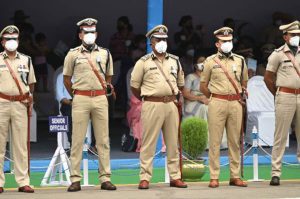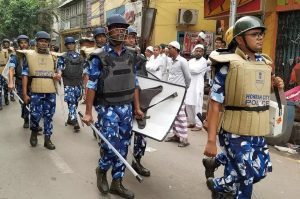Low Police-to-Population Ratio in West Bengal: The effectiveness of any law enforcement system is heavily dependent on the strength and distribution of its personnel. In West Bengal, this fundamental aspect of policing is under serious strain. The state suffers from one of the lowest police-to-population ratios in India, creating a precarious situation for law and order. With increasing urbanization, political mobilization, and social unrest, experts warn that unless the crisis is addressed with urgency, the consequences could ripple across public safety, justice delivery, and overall governance.

Understanding the Police-to-Population Ratio
The police-to-population ratio is a metric used globally to evaluate the adequacy of law enforcement relative to the civilian population. According to the United Nations standard, there should be at least 222 police officers per 100,000 population. In contrast, West Bengal has only around 97.66 police personnel per 100,000 people, significantly below both the UN benchmark and the national average of 152.80.
This means the state has fewer police officers per capita than most Indian states and is struggling to meet even its sanctioned strength due to systemic understaffing, delays in recruitment, and high attrition rates.


Historical Context and Structural Deficiencies
Colonial Legacy
West Bengal’s policing system, much like that of the rest of India, has its roots in the colonial era. Designed for control rather than service, it retained a hierarchical and command-based structure that struggles to adapt to modern policing demands. Despite a rapidly growing population and the rise of urban crime, reforms have been slow, leaving a gap between the institution’s capacity and society’s expectations.
Delays in Modernization
Initiatives like the Modernization of Police Forces (MPF) scheme have seen poor implementation in West Bengal. The lack of modern equipment, forensic labs, cybercrime units, and updated training methods have overburdened existing officers who must function with minimal technological support.
Current Manpower Crisis: Data and Ground Reality
Alarmingly High Vacancy Rates
According to government reports, West Bengal has a vacancy rate of 39.42% in its police force. This means tens of thousands of positions—particularly at the constable and sub-inspector levels—remain unfilled. The sanctioned strength is far from being met, and with retirements, resignations, and transfers, the situation continues to worsen.
- Constable Level Vacancies: Over 28,000
- Sub-Inspector and Officer Cadre Vacancies: Approximately 6,000+
This shortage leads to excessive workload on existing personnel, longer working hours, fewer patrols, and inadequate response to emergencies.
Uneven Distribution Across Districts
Another key issue is the uneven distribution of police forces. While Kolkata has a relatively better infrastructure, rural and semi-urban districts are critically underserved. Areas like Jhargram, Purulia, and parts of North Bengal face chronic staff shortages, leaving them vulnerable to crimes like trafficking, illegal mining, and extremist activity.
Impact on Law and Order
Rising Crime, Dwindling Response
With fewer boots on the ground, response times to crimes have increased, and so has public frustration. Crimes such as theft, domestic violence, cyber fraud, and gang violence often go unreported or uninvestigated due to resource constraints. Victims frequently complain of apathetic behavior, not due to negligence, but sheer lack of manpower.
Political and Communal Tensions
West Bengal has witnessed frequent outbreaks of political violence, especially during election seasons. The inability of the police to act impartially and promptly in high-tension areas is partly rooted in this personnel crunch. Communal incidents in Howrah, North 24 Parganas, and Cooch Behar have highlighted how inadequate force deployment can escalate tensions rather than defuse them.
Voices from the Ground: What Experts and Officers Say
Policemen Speak
Current and retired police officers admit that they are “stretched thin” and often must perform multiple roles simultaneously—traffic control, crime investigation, and even administrative tasks. A Kolkata-based sub-inspector noted:
“We barely get a day off. Forget investigating properly—sometimes we don’t even have time to write down a complete FIR. The manpower shortage is real, and it’s hurting everyone.”
Academic and Legal Observations
Dr. Ranjit Mukherjee, a criminologist at Jadavpur University, explained:
“An understaffed police force not only undermines daily law enforcement but also destroys public trust. The people start believing the police are either incompetent or partisan.”
Legal experts have echoed similar concerns, particularly on the failure to implement police reforms post the 2006 Prakash Singh judgment, which mandates depoliticization, fixed tenures, and institutional autonomy.
Comparative Analysis: West Bengal vs. Other Indian States
Better Performing States
States like Tamil Nadu, Maharashtra, and Kerala maintain a higher-than-average police-to-population ratio, and their crime response infrastructure is relatively efficient. This has led to quicker FIR registration, better crime resolution rates, and increased public cooperation.
Similar Underperformers
West Bengal is in similar territory with Bihar and Uttar Pradesh, which also struggle with vacancies and resource crunches. However, Bengal’s unique mix of urban political activism and rural insurgency risks makes its low police numbers even more dangerous.
Technological and Strategic Gaps
Underutilized Surveillance and Forensics
Despite efforts to introduce CCTV networks and cybercrime units, most districts outside Kolkata have minimal digital infrastructure. Cases involving digital fraud, cyberbullying, and organized scams often get delayed due to lack of personnel trained in digital forensics.
Inadequate Training and Morale
The existing police force lacks regular retraining. Morale is low due to:
- Long working hours
- Poor pay at entry levels
- Limited career mobility
- Political pressure
- Frequent lack of leave or backup
Recommendations: What Needs to Be Done
1. Immediate Recruitment Drive
The state government must fast-track police recruitment, especially for constables and sub-inspectors. Even if sanctioned posts are filled within 2–3 years, it would greatly improve visibility and response rates.
2. Decentralized Force Management
Each district, especially border and tribal districts, should be given autonomy to manage recruitment and deployment based on their crime profiles.
3. Community Policing Programs
Programs that engage citizen volunteers, retired officers, and local watch groups can help extend policing reach without additional burden.
4. Political Will for Reform
The West Bengal government must take a non-partisan approach to police appointments and transfers. Implementation of the Supreme Court-mandated Police Reforms is overdue.
5. Modern Infrastructure Investment
Investment in:
- Digital surveillance tools
- Vehicle fleets for rural patrols
- Forensic labs in tier-2 towns
- Cybercrime training centers
can dramatically improve both crime prevention and post-incident investigation.
Government Response and Policy Statements
While Chief Minister Mamata Banerjee has announced incremental police recruitments and new police stations, opposition leaders argue that the pace is insufficient and that the government is more focused on political appeasement than law enforcement enhancement.
The Home Department of West Bengal has proposed expanding the Civic Volunteer scheme, but critics warn that relying on untrained volunteers is no substitute for a trained police force.
Long-Term Societal Impact
Gendered Impact
Women are often the worst affected by understaffed police forces. Crimes against women, including domestic abuse, stalking, and molestation, require sensitive handling and dedicated cells, which are often absent or overburdened in Bengal.
Impact on Business and Tourism
International and domestic investors often cite poor law enforcement as a key deterrent to doing business in Bengal. Even the tourism industry, especially in areas like the Sundarbans, Darjeeling, and Digha, suffers from safety concerns due to inadequate police visibility.
Conclusion
The low police-to-population ratio in West Bengal is not just a bureaucratic statistic—it is a structural flaw that threatens public safety, civil order, and institutional credibility. With increasing crime rates, politicization, and public distrust, the state must act decisively. The roadmap includes recruitment, training, depoliticization, and modernization, but most importantly, it requires political courage and administrative commitment.
If the issue continues to be neglected, West Bengal could face a full-blown crisis in governance, where both the ruled and the rulers lose faith in the system meant to uphold justice and order.
External Resources
- West Bengal Police Official Website
- Bureau of Police Research and Development
- National Crime Records Bureau (NCRB)
- Supreme Court Judgment on Police Reforms (Prakash Singh Case)
Also read: Home | Channel 6 Network – Latest News, Breaking Updates: Politics, Business, Tech & More

